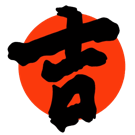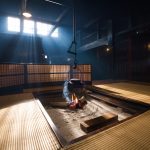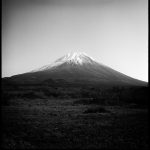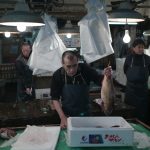Day 1: Tokyo
The trip starts off with some relatively relaxed activities in the biggest city on Earth. Our guests started their day early with a visit to Toyosu fish market, where they were accompanied by a chef who gave them an explanation of the different types of fish that are commonly used in sushi, and then helped them to select their own fish for a private sushi lesson later on. Today was also a chance for them to learn about different sake pairings, and the different types of spirits Japan has. From fruit liqueurs, to shochu there were hundreds of different drinks to choose from before finishing the night out with a visit to Kabukicho's world-famous Robot Restaurant.
Day 2: Tokyo
This day was dedicated almost entirely to learning and experiencing Japan's martial arts. Appropriately, we started the day with an early morning visit to a sumo stable, where our guests not only got the chance to see the rikishi conduct their morning matches and exercises, but also got an inner glimpse into what life is like for a sumo wrestler. Continuing with the theme, our guests made their way to a museum that is completely dedicated to Japan's former warrior class, the samurai. Everything from armors, and weapons to learning about the unique position these families held in Japan's history and the bushido code that they lived by. From there, they had the opportunity to experience martial arts first-hand as we prepared not only a demonstration, but a lesson in kendo for them to take part in. Entering a dojo is a great way to pull the curtain back and look behind the surface of Japan's martial arts culture. Even for those who are not interested in martial arts, visiting a dojo is a way to get a better understanding of how discipline plays a part in Japan's society.
Day 3: Tokyo
A visit to the manmade island of Odaiba is, for us, something that we highly recommend to our guests. It's within Tokyo, but the lack of skyscrapers, and the relative openness of the island make it feel like it was thrown in there from somewhere in the distant future. Housing all of Japan’s futuristic and concept technology, the island is home to many high tech hubs, and the Miraikan building is the center of it all, but Japanese corporations like Panasonic, Toyota, and Sony all have their respective concept hall for you to play with their concept technology. TeamLab's Borderless and Planet are living, moving, and reactive digital art spaces are here as well. After this, we planned a cruise across Tokyo Bay, through the Rainbow Bridge for our guests to prepare for their departure to Hachijojima. Traveling to Japan’s islands is always fun via boat. You get to wake up and see the islands dotting the seas during sunrise, and it’s more of a leisurely way to travel. We can easily book a flight to Hachijojima as well though, so if you would rather spend one more night in the city and fly in the morning, that can be arranged. This particular trip was reserved with a private cabin on the ship.
Day 4: Hachijojima
We arranged for our guests to stay at a very nice traditional ryokan near Hachijojima’s port. The daughter of the family that runs the establishment speaks English and has lived in New York for a few years. The food that they prepare includes ingredients fresh from their garden, and fish freshly caught that day. We chose this particular place, because of the attention that they pay to the small details. The accommodations also have a very nice large private bath for your enjoyment after your long day of hikes and nature exploration of this island’s volcano. Hachijojima also has glowing mushrooms in their forests in the summer months that are quite beautiful. All of the travel on the island of Hachijojima was arranged to be done on go-karts for these clients. The day started off with them going to Hachijofuji, which at 854 meters high, is the highest point of all of the Izu Islands and makes for a beautiful short hike to the top. The tall grass, and the volcano inside of a volcano view is amazing, and one of the best in Japan. From there, they ‘raced’ their way to one of the waterfalls in the middle of the island and then the beautiful ocean view onsen to watch the sunset over the never-ending sea. *For our guests who would like to ride go-karts while in Japan, please remember to bring an international driving permit. If you don’t have one, we can assist you with acquiring them.
Day 5: Aogashima
Aogashima is famous for many reasons. Although far out at sea, it is still under the jurisdiction of the Tokyo prefecture, and with a population of around 100 or so people, this makes it not only Tokyo's smallest community, but one of the smallest communities in all of Japan! This destination is popular with many astrophotographers who are looking to photograph the stars without the obstruction of light pollution, as the stars at night here can be seen very clearly. Our guests made their way to Aogashima by helicopter, and the views of the island from the air are spectacular, as the entirety of the island is pretty much a volcano shooting out of the sea. An active volcano at that. The residents of the island use the natural geothermal energy and steam of the volcano to cook with! While here our guests also enjoyed the island's unique shochu sake that is only made here.
Day 6/7: Aizu-Wakamatsu
The Aizu-Wakamatsu region is one that is very historically significant. We planned this stop as an opportunity to gather some historical perspective during the trip. It was one of the last strongholds for the shogunate forces before the Meiji era, and as such really continues, and holds on to a lot of the warrior samurai class traditions. We arranged for guides to walk our guests through the bukeyashiki samurai residences and explain to them not only how Japan’s society was structured during this period, but also the significance that the Aizu area held. Our guests stayed in the Higashiyama district while there, which looks like a traditional Japanese town that you would see in a movie. With the river running through the center, and the well-preserved buildings, the ryokan that we chose for them here is different from the Kyoto accommodation in that it is much more of a purist ryokan experience.
Day 8/9: Lake Kawaguchi
This leg of the trip was dedicated to Mt. Fuji, and the experiences that can be had on the beautiful and tranquil lakes that surround it. This was also a chance for them to relax a bit from the traveling that they had done up until this point, and so we arranged a stay at one of the best locations in the entire country that is known for its private, outdoor onsen baths that are en-suite and provide excellent views of Mt. Fuji. For this leg of the trip, we arranged a visit to one of Japan's highly regarded nihonshu breweries that exclusively uses water from Mt. Fuji in the brewing process, a trip to an open-air museum, where they enjoyed a cooking lesson, and tried their hand at traditional Japanese crafts, a visit to the area's iconic Chureito Pagoda and to mix things up, a visit to a theme park that has the world's fastest roller coaster!
Day 10: Kyoto
Kyoto, Japan's ancient capital is breeming with rich culture and tradition. Many people in Kyoto still consider it to be Japan's true capital. This day was planned with a focus on the traditional sides of Japan, with guided visits to some of its iconic shrines. Fushimi Inari is the main star (this is the world-famous shrine with thousands of bright orange torii gates going up the side of the mountain). We arranged for our guests to make their way around the city on bike. Biking up the Kamogawa river is such a fun way to see the city in the summer. There are normally people out performing music along the river, which gives it a unique and characteristically, ‘Kyoto’ feel. Kind of like hearing cicadas in summer. Today had fewer planned activities, so that our guests could relax if need be and take advantage of the hotels plush offerings if desired. After their visit to Fushimi Inari, we planned for an evening maiko performance to conclude the planned activities for that day.
Day 11: Himeji + Arashiyama
This day started with our guests taking an open-air, steam engine train that runs along a river that is lined with beautiful cherry blossom trees. They continued their journey on the river via a traditional boat ride that is manned by three people. The destination was the Arashiyama district, which has so many amazing sites it's hard to keep track of. The main one that they were visiting that day was Tenryuji Temple for its amazing zen garden, and the beautiful bamboo thicket behind it. Himeji Castle is the most majestic castle in the entire country. Just a short distance from Kyoto, this castle is also known as the White Crane Castle, because its shape resembles a white crane taking flight. Having a knowledgeable guide to give you all of the history about the castle as you walk through the castle grounds is a must. The rest of the day was dedicated to free time in Kyoto, and we made dinner reservations for them at a restaurant in Pontocho for that night.
Day 12 (Kyoto)
In order to provide our guests with a little bit of free time to explore Kyoto on their own, we left this day relatively open for them to do a few things on their own. The only planned activity for this day was a guided day trip to Nara for them to explore that area, and also to see the deer that roam the temple grounds freely.
Day 13 (Osaka)
At Kichi Japan, we try our best to plan a traditional matsuri festival experience into most of our itineraries, and so this day was all about the Aizen Matsuri. This is the perfect chance to go out in a yukata, eat Japan’s delicious street foods, and to see Japanese people let loose. The events include parades, a mikoshi procession, and the chance to try out some of the traditional matsuri games with the locals. For our guests final night we planned a cruise through the Dotonbori Canal, a street food tour, and a karaoke bar hop, all before heading back to Tokyo in a private compartment on the last surviving (regularly running) overnight train in the entire nation.



